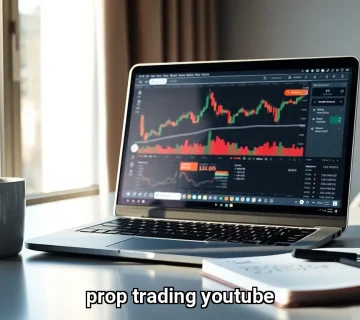In the dynamic realm of finance, the choice between prop trading vs quant trading can shape a trader’s career and strategy. Prop trading involves using a firm’s capital—like the funding provided by Propx Pro—to execute trades based on market insights and risk management skills. In contrast, quant focuses on leveraging data, mathematical models, and automation to optimize trading strategies. While prop trading thrives on speed, intuition, and market adaptability, quant emphasizes systematic analysis and algorithmic precision. Firms like Propx Pro provide traders with access to capital and advanced technology, helping them navigate both discretionary and quantitative trading approaches in today’s competitive financial landscape.
As you delve into the nuances of prop trading vs quant, you’ll uncover essential distinctions that can guide your career decisions or investment strategies. Are you more inclined toward the fast-paced, instinctual methods of prop trading, or does the analytical, systematic approach of quant trading resonate with your skills? This exploration will not only clarify the operational differences but also illuminate the skills and risk management strategies involved in each. Furthermore, understanding these methodologies can position traders to better adapt to market changes and align their strategies with their personal strengths. Join us as we unpack these trading methodologies, ensuring you have the knowledge to navigate your financial journey effectively and make informed decisions that suit your trading style.

Prop Trading vs Quant Trading
In the world of finance, two prominent trading approaches have emerged, each with its unique methodologies, goals, and skill requirements: prop trading vs quant trading. Understanding the nuances between these two strategies can provide aspiring traders with clarity on which path may align with their skills and goals. Prop trading, short for proprietary trading, involves traders using a firm’s capital to make trades.
This approach emphasizes immediate market engagement, where traders can employ various strategies, including day trading, swing trading, or arbitrage. The primary objective of prop trading is to generate profits for the trading firm, which can lead to significant financial rewards for traders who perform well. This profit-driven nature creates a competitive environment that pushes traders to continuously enhance their skills and adapt to changing market conditions, ultimately shaping their trading careers.
Conversely, quant trading, or quantitative trading, relies heavily on mathematical models and algorithms to identify trading opportunities. This method allows traders to leverage quantitative analysis to create strategies that can be backtested and automated. Unlike prop trading, which may focus on subjective market insights, quant trading is data-driven, often leading to strategies that include statistical arbitrage, high-frequency trading, or machine learning models.
The aim is to execute trades based on rigorous data analysis, ensuring a systematic approach to the market. This analytical framework not only improves consistency but also helps mitigate risks, as strategies are often tested against historical data before real capital is deployed. As a result, quant trading appeals to those who prefer a structured and logical approach to trading, relying on data rather than instinct.
One of the key differences in the prop trading vs quant debate lies in the level of risk associated with each strategy. Prop traders typically take on more risk since they are trading with the firm’s money. This can lead to higher potential rewards but also greater losses if trades do not perform as expected. In contrast, quant traders often utilize sophisticated quantitative risk management techniques that allow them to minimize risk exposure while maximizing potential returns.
These techniques can include predictive modeling, which anticipates market movements based on historical data. By employing such strategies, quant traders can navigate the complexities of the market without succumbing to the emotional pressures that often accompany trading decisions, thereby enhancing their long-term success.
Understanding Prop Trading
Prop trading is a practice that allows traders to execute trades using their firm’s capital instead of clients’ funds. This structure incentivizes traders to seek profitable opportunities aggressively while managing the associated risks. Prop traders often operate in fast-paced environments, making split-second decisions based on market conditions, news events, and technical indicators. The primary goal is to generate profits for the trading firm, which often directly correlates with the trader’s compensation. This performance-based model creates an environment where traders are motivated to continuously refine their strategies, analyze market trends, and leverage their instincts to capitalize on opportunities.
Traders in a proprietary trading firm may employ diverse strategies to achieve this goal, including day trading, where positions are opened and closed within a single trading day, or swing trading, which involves holding positions for several days or weeks to capitalize on expected market moves. Arbitrage is another strategy frequently used by prop traders, allowing them to exploit price discrepancies between different markets or instruments. This flexibility in strategy selection enables prop traders to adapt to various market conditions and pursue opportunities across different asset classes, making it a dynamic and engaging field.
However, the high-risk nature of prop trading means that traders must be exceptionally disciplined and skilled in risk management. Since they are using the firm’s capital, any losses directly impact the firm’s bottom line, which can create pressure to perform consistently. Firms can provide aspiring traders with the tools and resources needed to hone their skills and adopt effective trading strategies. By focusing on training and mentorship, these firms help traders understand market dynamics and develop the necessary acumen to succeed in prop trading. This support structure not only enhances traders’ abilities but also fosters a culture of continuous learning and improvement, which is essential for long-term success in such a competitive environment.

Introduction to Quant Trading
Quant trading, on the other hand, represents a departure from traditional trading methods, leveraging technology and quantitative analysis to drive trading decisions. At Propx Pro, quant traders utilize sophisticated mathematical models and algorithms to analyze vast amounts of data, identifying patterns and opportunities with precision. By backtesting strategies against historical data, they ensure effectiveness before deploying real capital, minimizing risk and maximizing efficiency. This data-driven approach allows quant traders to remain objective, reducing emotional biases—a crucial advantage in the volatile world of finance. At Propx Pro, both prop and quant trading coexist, offering traders diverse opportunities to excel based on their strengths and preferred methodologies.
One of the defining features of quant trading is its emphasis on automation. Traders develop algorithms that can execute trades automatically based on pre-defined criteria, allowing for faster and more efficient trading than manual methods could achieve. High-frequency trading is a subset of quant trading, where algorithms execute a large number of orders at extremely high speeds to capitalize on tiny price movements. This requires robust technology and infrastructure, as well as sophisticated risk management techniques. The automation of trading processes not only increases the speed of execution but also reduces the potential for human error, further enhancing the reliability of quant strategies.
The skill set required for quant trading is distinct from that of prop trading. While both types of traders must possess analytical skills, quant traders must also be proficient in programming and data analysis. Familiarity with statistical methods and financial mathematics is crucial for developing effective trading algorithms. This technical expertise allows quant traders to create models that can adapt to changing market conditions, making it a highly dynamic and innovative field within finance. As technology continues to advance, the demand for skilled quant traders is likely to increase, further solidifying their role in modern financial markets.
Comparing Trading Strategies
When considering prop trading vs quant trading, a critical aspect to examine is the diversity of trading strategies employed by each. At Propx Pro, prop traders leverage their market instincts and experience to make real-time decisions, utilizing strategies such as technical analysis, trend following, and sentiment evaluation. This flexible approach allows them to react swiftly to market shifts, capitalizing on opportunities as they arise.
In contrast, quant traders at Propx Pro rely on data-driven models and algorithmic strategies to execute trades with precision and efficiency. While prop trading offers the potential for significant profits through discretionary decision-making, quant trading minimizes emotional biases by automating processes. Understanding these key differences can help traders determine the best fit for their skills and trading goals.
In contrast, quant traders depend on data-driven strategies that can be backtested and refined over time. They often employ statistical arbitrage, which involves identifying mispricings in financial instruments and executing trades to exploit these discrepancies. Machine learning models are increasingly being integrated into quant strategies, enabling traders to use algorithms that can learn from historical data and improve their predictive capabilities. This reliance on technology can lead to more consistent performance, as quant models can eliminate emotional decision-making. Additionally, the ability to backtest strategies against historical data provides quant traders with a level of confidence that can be crucial in decision-making processes.
As the financial landscape evolves, the interplay between prop and quant trading continues to grow. The rise of big data and advanced analytics has fueled the popularity of quant trading, but prop trading remains a vital component of market dynamics. Both approaches have their strengths and weaknesses, and the choice between them often depends on individual trader preferences, skills, and risk tolerance. Understanding these differences is essential for aspiring traders as they navigate their career paths and seek to align their strategies with their unique strengths and market conditions.
The Rise of Quantitative Trading
The emergence of quantitative trading has transformed the way markets operate, leading to a significant shift in trading strategies and practices. With the advent of high-frequency trading and complex algorithms, quantitative trading has become a dominant force in financial markets. The ability to analyze vast amounts of data in real-time allows quant traders to capitalize on fleeting opportunities that traditional traders might miss. This shift has not only changed the way trading is conducted but has also influenced market volatility and liquidity, creating a more complex trading environment.
This rise in quant trading has been supported by advancements in technology, including machine learning and artificial intelligence, which enable traders to create more sophisticated models and strategies. As a result, firms that specialize in quantitative trading have become increasingly influential in the financial world, often competing with traditional investment methods. Platforms are at the forefront of this evolution, providing traders with the tools and resources necessary to harness the power of quantitative analysis effectively. These platforms often facilitate the integration of advanced analytics and data processing capabilities, allowing quant traders to enhance their strategies further.
One of the benefits of quantitative trading is its potential for scalability. Once a trading algorithm is developed and tested, it can be deployed across multiple assets and markets, allowing firms to scale their operations without a corresponding increase in overhead. This efficiency can lead to higher profit margins and more robust investment strategies. However, the reliance on technology also introduces new challenges, such as the need for continuous monitoring and adaptation to changing market conditions. As market dynamics shift, quant traders must remain vigilant and adaptable, ensuring their models remain effective in achieving desired outcomes.
In summary, the landscape of trading is continuously evolving, and understanding the differences between prop trading vs quant and prop trading vs quant trading is essential for anyone looking to enter the field. Each approach offers unique advantages and faces distinct challenges. With the right tools, training, and strategies, traders can navigate this complex environment and find success in their chosen path. The decision between prop and quant trading ultimately comes down to personal preferences, skill sets, and the level of risk that an individual trader is willing to accept in pursuit of financial success.




No comment